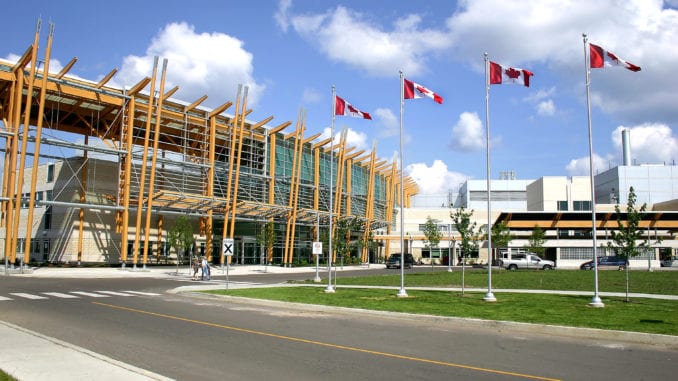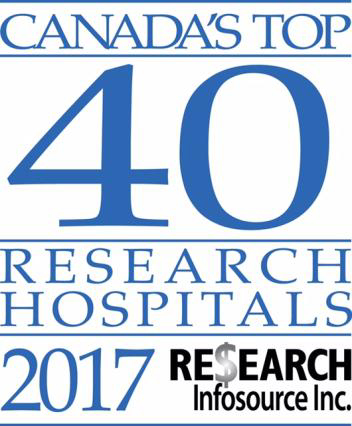

FOR IMMEDIATE RELEASE
(Thunder Bay, ON – December 18, 2017) — After debuting on the list of Top 40 Research Hospitals in Canada in 2010, Thunder Bay Regional Health Sciences Centre (the Hospital) continues to rank among the leading health research institutions in the country.
 Seven years ago, the Hospital appeared on the list for the first time, entering at #40. This year, Thunder Bay Regional Health Sciences Centre occupies the 38th position.
Seven years ago, the Hospital appeared on the list for the first time, entering at #40. This year, Thunder Bay Regional Health Sciences Centre occupies the 38th position.
The research activity that catapulted the Hospital into Canada’s Top 40 Research Hospitals is attributed to the ongoing success of our research arm, the Thunder Bay Regional Health Research Institute, and to internal and external partnerships such as in relation to clinical trials.
Incorporated as the Thunder Bay Regional Research Institute in December 2007 and renamed the Thunder Bay Regional Health Research Institute in November 2016, the program is the research arm of our Hospital. Its mandate is to facilitate health research – particularly in the area of technology and related innovations – strategic to regional health care needs. Current research areas include but are not limited to cancer, cardiac disease, stroke, orthopaedics, Indigenous health, and lung disease.
“To be recognized as one of Canada’s Top 40 Research Hospitals for a seventh consecutive year is not only a great accomplishment for our Hospital and Health Research Institute, but also a source of pride for our community and the stakeholders and donors who support us”, said Jean Bartkowiak, President & CEO of the Hospital and CEO of the Health Research Institute. “Our research aims to improve patient care in Northwestern Ontario and to make our region healthier, wealthier and smarter.”
A robust health research program is vital to advancing our academic mission and even more importantly, to improve the health of the population. It provides patients and others with the opportunity to participate in research activity that helps design the care of the future and to access equipment at the frontier of health technology development, such as the PET/CT scanner, used to diagnose lung cancer; the 3T MRI machine, currently combined with a polarizer to conduct gas imaging for lung disease and dementia; the cyclotron, which will eliminate the Hospital’s dependence on outside sources of radioactive isotopes used for specific diagnostic imaging procedures; and emerging technologies, such as innovations in high intensity focused ultrasound and mobile positron emission breast imaging.
The Hospital serves a region that faces many health challenges, including distance to health care services and poorer health outcomes. Dr. Abraham (Rami) Rudnick, VP of Research at the Hospital, and Chief Scientist at the Health Research Institute sees technology as one of the keys to overcoming Northwestern Ontario’s geographical barriers to health care delivery, “Mobile technology for remote access to health services can help improve health outcomes considerably. We want to do more and do it in a more timely fashion early detection, early intervention. Technology can help us do that as close to home as possible,” said Rudnick. “The Health Research Institute can continue to grow as a leader when it comes to using technology to improve health outcomes considerably.”
In many ways, Northwestern Ontario is the perfect size for research in relation to remote health care. It’s large enough to support a research centre, yet small enough to encourage collaborations between scientists and clinicians as well as service users. Much of the ongoing research at the Health Research Institute is already focused on customized, patient-centered solutions to regional challenges.
The poor status of health of the Indigenous population is one of those regional challenges Indigenous communities in Northwestern Ontario require a special focus due to higher rates of diabetes, cancer, renal failure, amputations, addiction, mental health challenges including suicide, and other health care issues. Research in this area is being conducted in collaboration with Indigenous communities and with their leadership.
“Clearly there is a health need, but it’s not just about the clinical aspects of care. It’s also about social determinants of health. There is a lot of opportunity to help here,” said Rudnick. He added that compounding the problem is the fact that health outcomes are not as good in rural areas as they are in urban centres for a variety of reasons. That issue exists around the world. “Considering we know many of the problems, it’s time to address them in a cutting-edge way. ”
Another important part of the Hospital’s research program is clinical trials, which has a particularly positive impact on patient care. Clinical trials are research studies investigating new treatment delivery methods, medications, medical devices, health software, and other health care issues to improve care for future patients. There are dozens of clinical trials underway at the Hospital at any given moment.
The Health Research institute’s current strategic plan reinforces its focus on patient-centred research and the strong partnership with the Hospital. The 2020 Strategic Plan was developed by engaging key partners such as health professionals, academic institutions, communities, health managers, and policymakers.
By design, the Health Research lnstitute’s Strategic Plan also serves as the principal research plan for the Hospital. It highlights three major directions:
Healthier: Enhance research to improve the health outcomes of the people of Northwestern Ontario and beyond; Wealthier: Enhance philanthropic and other support and generate revenue through science and partnerships; and Smarter: Enhance the academic environment.
These directions will address the Health Research Institute’s vision of ‘bringing discovery to life.’
“Our Health Research Institute is part of an academic health sciences centre that allows both the cross-pollination of scientific questions and ideas to address regional population health challenges significant enough to sustain a strong research program,” said Bartkowiak. “Working together with academics, scientists, clinicians, funding agencies and industry partners helps us develop a truly Northwestern Ontario research program that is patient-centred.”
To learn more about the Thunder Bay Regional Health Research Institute and its 2020 Strategic Plan, visit www.tbrhri.ca
To learn more about Thunder Bay Regional Health Sciences Centre, visit www.tbrhsc.net
The Top 40 list is a compilation by Research Infosource to emphasize the very important role that hospitals play in Canadian medical research. Canada’s Top 40 Research Hospitals List 2017 is available on the Research Infosource website: https://www.researchinfosource.com/pdf/2017 Top 40 List – Final.pdf
— 30 —
For further information, please contact:
Marcello Bernardo
Communications Officer
Email: bernarma@tbh.net
Tel: (807) 684-6765
Healthy Together
Thunder Bay Regional Health Sciences Centre (TBRHSC), a 375-bed acute care facility, is a national leader in Patient and Family Centred Care. As the tertiary care provider in Northwestern Ontario, TBRHSC provides comprehensive services to a population of over 250,000 residents in a region the size of France.
